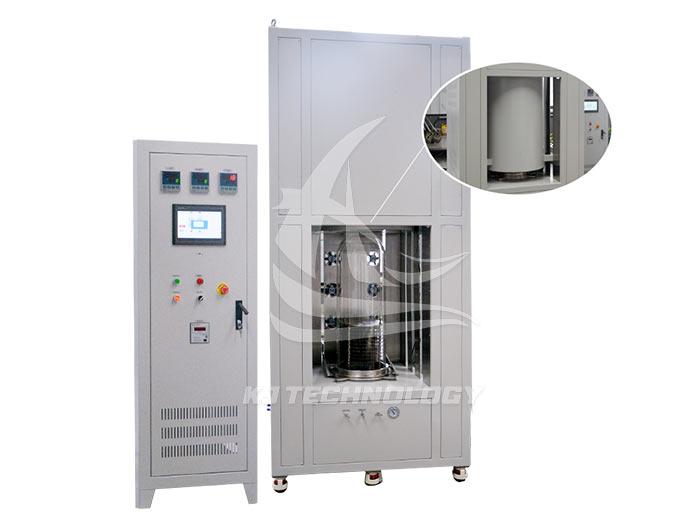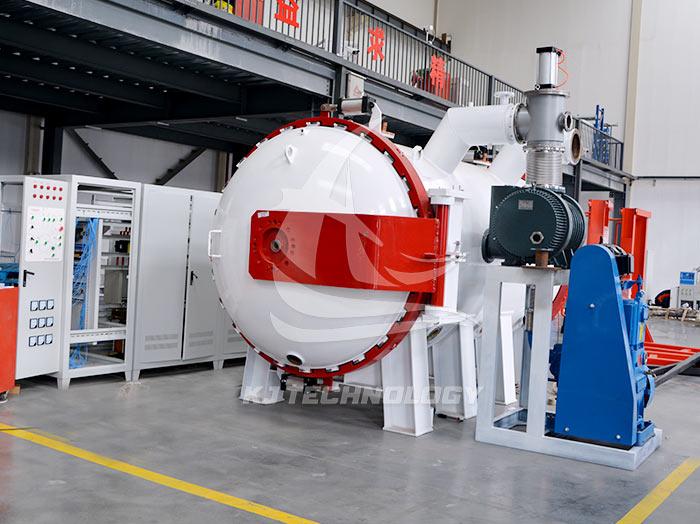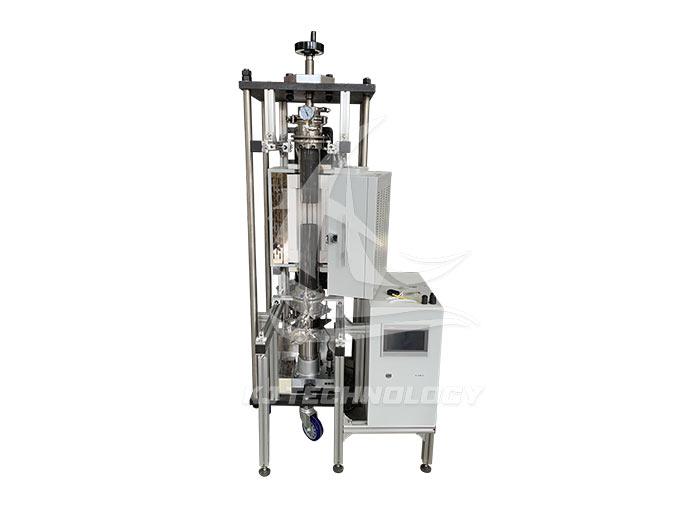What gases can be used in a laboratory vacuum furnace?
 06-26-2025 Author: KJ technology
06-26-2025 Author: KJ technology
The laboratory vacuum furnace can introduce various gases according to process requirements, and its core function is to optimize material properties by precisely controlling the atmosphere environment. The following is a detailed explanation of common gas types, application scenarios, and precautions:
1. Common types and functions of incoming gases
Inert protective gas: Ar (argon gas), metal heat treatment (annealing, quenching), ceramic sintering, powder metallurgy to isolate oxygen and prevent oxidation; As a carrier gas for transporting reactants, the purity should be ≥ 99.999% (5N grade) to avoid impurity contamination.
N ₂ (nitrogen): nitriding treatment (such as surface hardening of steel), stress relief annealing of 3D printed metal parts, participating in nitriding reaction to form a hard layer; Inert protection may react with certain metals (such as Ti) at high temperatures, and temperature control is required.
Reductive gases: H ₂ (hydrogen), metal reduction (such as tungsten powder reduction), semiconductor epitaxial growth, carbon material purification, reduction of metal oxides; To remove oxygen impurities from carbon materials, hydrogen concentration monitoring and explosion-proof devices are required, with a concentration typically ≤ 5% (by volume).
Reactive gases: O ₂ (oxygen), metal oxidation (such as Al ₂ O Ⅲ coating preparation), ceramic densification sintering, promote oxidation reaction; To control the porosity of the material, it is necessary to precisely control the flow rate (such as 0.1-10 sccm) to avoid excessive oxidation.
CH ₄ (methane): Chemical vapor deposition (CVD) is used to prepare diamond and carbon nanotubes, providing a carbon source that decomposes into carbon materials at high temperatures. It needs to be mixed with H ₂ (such as CH ₄: H ₂=1:9) to control the deposition rate.
NH3 (ammonia gas): Silicon nitride film deposition, gallium nitride (GaN) epitaxial growth, providing nitrogen source, participating in compound semiconductor growth, highly toxic gas, requiring strict sealing and exhaust gas treatment.
Mixed gas Ar+H ₂: sintering and reduction of refractory metals (such as molybdenum and tantalum) combined with the inertness of Ar and the reducibility of H ₂, typical ratio: Ar 90% -95%+H ₂ 5% -10%.
N ₂+H ₂: Nitriding treatment (such as ion nitriding), where N ₂ provides a nitrogen source and H ₂ promotes nitrogen atom diffusion, requires precise control of the ratio (such as N ₂: H ₂=3:1) to avoid hydrogen embrittlement.
2. Core principles of gas selection
Compatibility with materials
Case: Titanium alloy will react with N ₂ to form TiN brittle phase above 600 ℃, so it is necessary to avoid introducing N ₂ and use Ar or vacuum environment instead.
Data: A study showed that the tensile strength of Ti-6Al-4V alloy reached 950 MPa after annealing in Ar atmosphere, but decreased to 820 MPa in N ₂ atmosphere.
Process target matching
Oxidation control: If a completely oxygen free environment is required, a vacuum (<10 ⁻³ Pa) should be maintained or high-purity Ar/N ₂ should be introduced.
Surface modification: If an oxide layer (such as Al ₂ O3) needs to be formed, precise control of O ₂ flow rate (such as 0.5 sccm) and temperature (such as 1000 ℃) is required.
Security and Cost
Hydrogen risk: The explosion limit of H ₂ is 4% -75% (by volume), and it needs to be equipped with:
Hydrogen concentration sensor (response time<1 second);
Automatic shut-off valve and explosion-proof fan;
Exhaust catalytic combustion device (converts H ₂ to H ₂ O).
Cost optimization: There is a significant price difference for high-purity gases (such as 5N grade Ar at around 200 yuan/m ³ and 9N grade Ar at over 1000 yuan/m ³), and the selection should be based on experimental accuracy requirements.
3. Key technologies for gas introduction into the system
Flow and pressure control
Mass Flow Controller (MFC): Accuracy ± 0.5% F.S., capable of achieving sccm level flow control (e.g. 1 sccm=1 cm ³/min @ standard state).
Back pressure valve: Maintain stable pressure inside the furnace (such as ± 0.1 kPa) to avoid gas backflow or leakage.
Gas Purification and Monitoring
Purifier: removes impurities such as O ₂ and H ₂ O (such as zirconium aluminum absorber purifiers, which can reduce O ₂ content to<1 ppb).
Residual Gas Analyzer (RGA): Real time monitoring of the atmosphere composition inside the furnace (if an O ₂ peak is detected, an alarm is triggered).
Safety interlock design
Gas leakage alarm: sound and light alarm+automatic cut-off of gas source;
Interlocking logic: When hydrogen gas is introduced, it is forbidden to open the furnace door, and the vacuum pump and gas valve are interlocked.
4.Typical application cases
Semiconductor industry
Process: SiC epitaxial growth
Gas: high-purity H ₂ (carrier gas)+C ∝ H ₈ (carbon source)+SiH ₄ (silicon source)
Parameters: Temperature 1600 ℃, pressure 100 Torr, H ₂ flow rate 10 slm
Result: Uniformity of epitaxial layer thickness ± 1%, defect density<10 ³ cm ⁻ ²
Metallic materials
Process: Vacuum heat treatment of high-temperature alloy (Inconel 718)
Gas: Ar (protective gas)+trace H ₂ (deoxygenation)
Parameters: temperature 980 ℃, vacuum degree 10 ⁻⁴ Pa, H ₂ flow rate 50 sccm
Result: Surface oxide layer thickness<5 nm, room temperature tensile strength increased by 15%
New energy materials
Process: Carbon coating of negative electrode material (SiOx) for lithium-ion batteries
Gas: Ar (protective gas)+CH ₄ (carbon source)
Parameters: Temperature 800 ℃, CH ₄ flow rate 20 sccm, processing time 2 hours
Result: The initial charge and discharge efficiency increased from 75% to 92%, and the cycle life was extended by three times
5.Summary and Suggestions
Gas selection core logic
Protection priority: Ar/N ₂ is preferred for easily oxidizable materials such as Ti and Cu;
Reaction control: Introduce active gases (such as O ₂, CH ₄) when surface modification is required;
Safety red line: The use of hydrogen must strictly comply with explosion-proof regulations.
Equipment selection suggestions
Basic requirement: Choose an entry-level vacuum furnace with MFC and back pressure valve (such as the domestically produced Hefei Kejing VTF series), supporting Ar/N ₂/H ₂ single gas inlet;
High end demand: Imported equipment (such as German PVA TePla) can achieve multi gas dynamic switching (such as Ar → H ₂ → O ₂ gradient control) and support in-situ atmosphere monitoring.
Operating specifications
Before ventilation, it is necessary to evacuate to<10 ⁻ ² Pa to avoid gas mixing and explosion;
After the experiment, blow the furnace chamber with inert gas to prevent residual active gas from corroding the equipment.
By selecting gas types and control parameters reasonably, laboratory vacuum furnaces can significantly improve material properties and process repeatability, providing key support for high-end manufacturing and scientific research.








